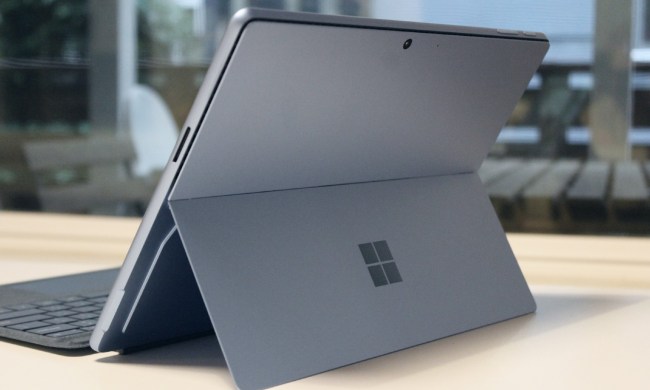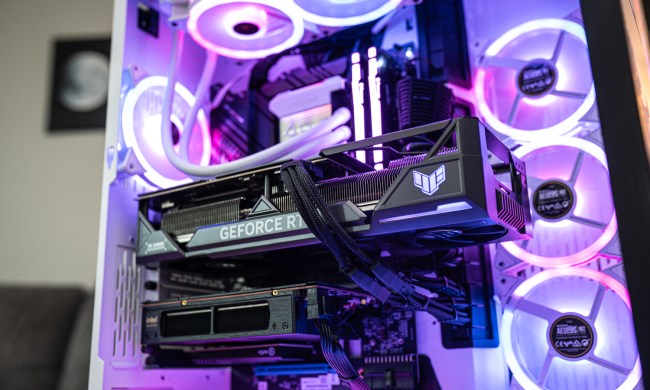“...we'd easily recommend the Dash over a low-end Dell, HP or similar big-name vendor's offerings without hesitation.”
- Very quiet
- small and light; decent gaming performance; affordable
- Needs better setup guide; upgrade instructions would be appreciated
Summary
Good news, FPS addicts… There’s no need to worry if funds are tight, as custom computer builder Maingear has developed the Dash PC as a low-cost alternative to its boutique gaming rigs, albeit with the same attention to detail and unique design that are the hallmarks of a personalized machine. The thinking being, of course, that if you are a gamer and like Maingear, but can’t afford one of the provider’s higher-end systems, when your friends and family need a recommendation, you’ll tell them to pick this puppy up. Happily, we concur that this’d be a wise choice, considering the machine’s general level of elegance, craftsmanship and performance. Granted, the system’s manual needs updating and some more detailed upgrade instructions would help. But overall, it’s an excellent machine, especially when you take into account the unit’s cut-rate price.
* Edit 4/27/08 – Maingear informed us that the wrong manual had been accidently packed with our test system. They emailed us a PDF copy of the Maingear Dash manual which is in fact informative and complete.
Features and Design
Basically, the Dash is a small form-factor PC that is not quite as tiny as a Shuttle system, but still much more petite than a traditional mid-tower. Its SG03 chassis is made by Silverstone, which is known for building incredibly elegant aluminum PC cases, and measures just 14.5 inches tall and a bit over 12 inches long. It’s available only in black, and has two front panels that swing open to reveal I/O ports, as well as a dual 120mm fan cage that cools the interior of the PC.
True, you can customize the Dash when ordering. But your options are limited, as Maingear has settled on an AMD platform for the machine. The manufacturer is also trying to keep the cost of the Dash relatively low, so most upgrade choices are mid-range parts that won’t break the bank. You can select whether you want a dual- or quad-core CPU though. Not to mention, that is, if you want to add a second hard drive, upgrade the videocard, tack on an LCD display and more. For reference, our review system came with a dual-core AMD Athlon X2 6000+ clocked at 3.0GHz, and 2GB of Corsair DDR2 memory.
The videocard setup on the Dash is interesting, as it uses ATI’s new hybrid Crossfire system, which pairs the motherboard’s onboard video chipset with a discrete add-in card. In this case, Maingear configured the Dash with a 512MB ATI Radeon HD 3450, which is paired up with the onboard graphics of the AMD RS780 chipset.
You can have up to two hard drives in the Dash, the biggest being 500GB. Our test unit came with a lone 320GB Western Digital drive. It also came with an integrated media reader, onboard audio and a 20X DVD-R/RW drive. You can opt for a Blu-ray burner and HD DVD-ROM as well, but it’ll run you an extra $300 USD.

The Dash is a small form-factor PC that is bigger than a Shuttle, but tinier than a mid-tower.
Use and Testing
When we first saw the Dash’s box, we did a double-take. “How small is this PC?” we couldn’t help thinking. And after removing the wrapping, we weren’t just surprised by how tiny it was, but also how light. We easily lifted the system up and out of the box and set it down underneath our desk, though it could easily fit on top too. Inside the box we also found a Maingear t-shirt and a binder with the word Dash on its cover.
The binder is a nifty touch and we wish all vendors would use them. The included binder even had a thank you letter from Maingear (a nice touch) followed by two pages of QA checkboxes such as “installed latest video card drivers,” and so forth. The only problem was a bunch of the boxes weren’t check marked and remained empty, such as “Is front panel USB on?” This leads us to believe they weren’t checked, which sort of defeats the purpose of showing customers all this initial groundwork was done.
Second, there’s a page titled “Initial setup of your system,” but the info and pictures are ancient and depict PS2 mouse and keyboard connectors along with info on how to connect your videocard to a hardware MPEG-2 decoder. (We haven’t seen one of those in at least five years, if not longer.) It’d be better if it were up-to-date, and explained all the various ports and connectors on the back and front of the machine. After all, this is supposed to be a system for newbies and beginners, and they need as much hand-holding as possible.
Finally, section four of the manual is titled, “SLI info,” but this system doesn’t use SLI; it uses Crossfire technology, making the fact that the manual specifically states that this is an NVIDIA feature and tells the user how to enable it even stranger. We’re not trying to be too harsh on what is obviously an ancillary item, but it’s odd that the company would go to all the trouble of showing customers its eye for detail, then let so many little things fall through the cracks. In other words, the manual is not specific to this model of PC, and it way too generic to be a good guide.
First Boot and Gaming
Once the machine was up and running, we were quite pleased with its performance and silent operation. It booted to the Windows Vista desktop in 53 seconds, which is better than average. Maingear even offers customized boot and shutdown menus with its logo, which is slick. We were very pleased to see an extremely lean installation of Vista too, with zero bloatware installed. The only extra links on the desktop were to free anti-virus software and free office suite software, which is fine with us as those are useful programs.
Furthermore, the Dash’s general performance in Windows was excellent, as the system was extremely responsive and felt very fast in testing. Its Windows Experience Index is a decent 4.1, and the Dash scored a solid 3,787 in PCMark Vantage, which isn’t too shabby considering its relatively low price tag.
Though the Dash isn’t billed as a gaming rig, and is essentially running a $50 videocard combined with onboard graphics, it is actually capable of decent gaming performance, which surprised us. We were able to play Call of Duty 4, Portal and Crysis just fine on the system, albeit at low resolution. Still, that’s an impressive feat for a machine with specs like this. For number junkies, we ran 3DMark 06 as well, and the PC scored 2,220, which is on the low end of the scale, but not surprising given the unit’s specs.
Upgrades
Finally, given the design of the chassis interior we were curious as to how a user would go about upgrading or swapping out parts, since the PSU resides over the CPU area and the hard drives are not easily accessible since they lie on the floor. Here’s what the Dash looks like with its door removed.
The PSU is mounted above the CPU, with the hard drive(s) down below on the bottom of the chassis.
Given the chassis’ unique design, and the fact that it’s targeted towards “friends and family,” we expected to find simple, clear instructions on how to add another hard drive, swap out the PSU, etc. But Maingear doesn’t provide any instructions at all. Instead, the company includes the Silverstone manual in a small box that comes with the system, and though the manual is somewhat easy to follow, the pictures are tiny and a lot of the diagrams resemble schematic drawings, making it far from user-friendly, in other words. Frankly, it would not be difficult for Maingear to add a few pages to the manual depicting how to add and remove components from the chassis, and given its atypical layout, we’re sure the effort would be greatly appreciated.
Speaking of upgrades, if one were to go down that path, we give Maingear props for the excellent wiring in the Dash. It’s incredibly clean, and all excess cabling is neatly zip-tied and out of the way. Clean cabling has always been a hallmark of the boutique PC experience, so it’s good to see a high-end feature like that come to such an affordable alternative.
Conclusion
The Dash is an interesting concept, and we think Maingear has largely done a very good job with it. Picture it as sort of a “mini-boutique” rig that looks like a custom PC and performs like one, plus includes the same high-quality tech support (we say this based on our previous experience with the company) as a hand-built machine, but costs much less. That’s a winning package for sure, and we’d easily recommend the Dash over a low-end Dell, HP or similar big-name vendor’s offerings without hesitation. Sure, there are still several areas in which Maingear can improve the customer experience, as we noted in our review. Once Maingear irons out the documentation, there is nothing stopping this system from receiving our coveted Editor’s Choice award.
Pros:
• Very quiet, small and light
• Decent gaming performance
• Affordable
Cons:
• Needs better setup guide
• Upgrade instructions would be appreciated
• Not as muscular as average boutique PC



